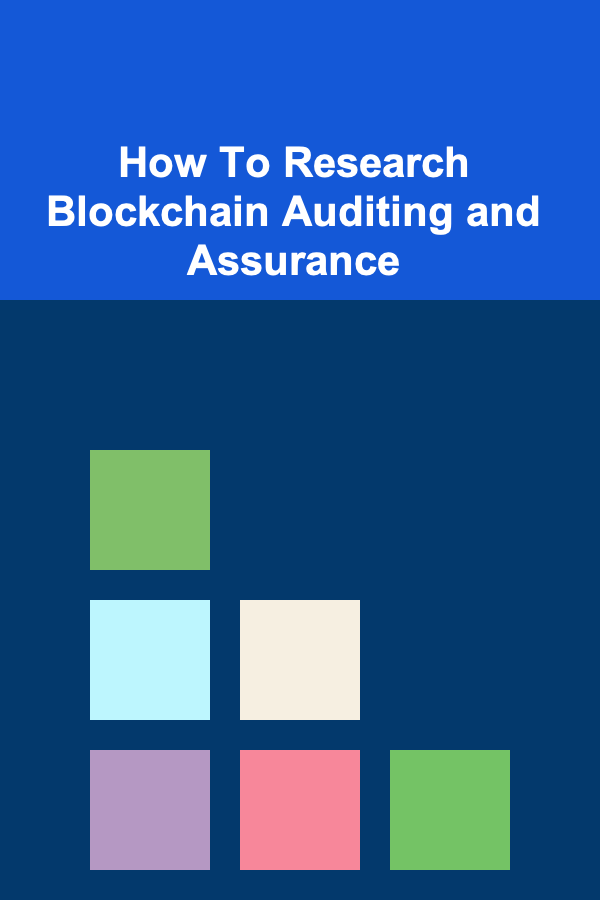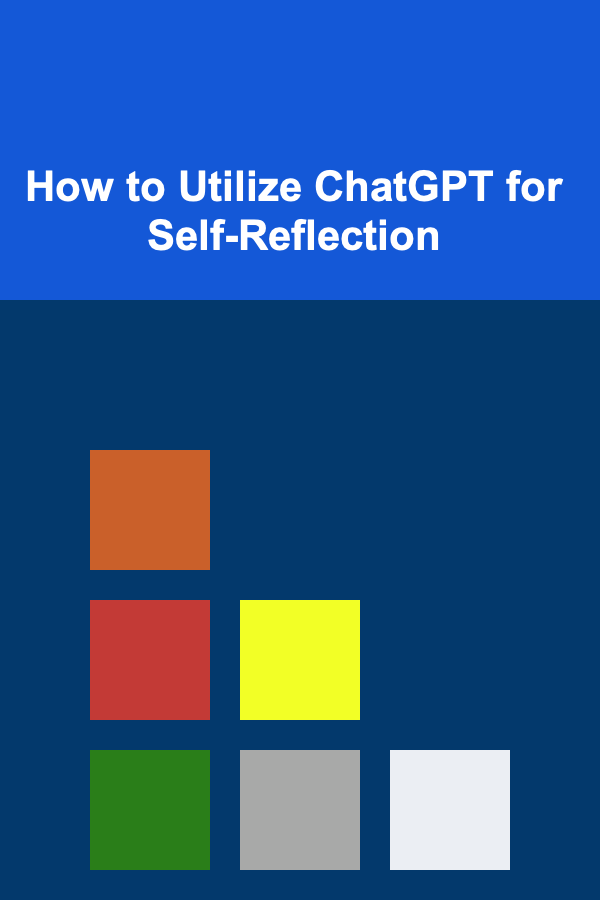
How To Research Blockchain Auditing and Assurance
ebook include PDF & Audio bundle (Micro Guide)
$12.99$6.99
Limited Time Offer! Order within the next:

In the rapidly evolving world of blockchain technology, the demand for secure, reliable, and transparent systems is more critical than ever. Blockchain is praised for its decentralization, immutability, and transparency, but it is not without its vulnerabilities. Blockchain auditing and assurance are essential to ensure that these systems are functioning as intended, free from errors, fraud, or malicious activity. However, researching blockchain auditing and assurance can be a daunting task due to the complexity of blockchain systems and the evolving landscape of cybersecurity threats.
This article will guide you through the process of researching blockchain auditing and assurance, providing insights into the fundamental concepts, methodologies, tools, and challenges in this area.
Understanding Blockchain Auditing and Assurance
What is Blockchain Auditing?
Blockchain auditing refers to the process of examining and evaluating blockchain transactions, smart contracts, and system components to ensure compliance with rules, regulations, and security standards. The goal of blockchain auditing is to verify that blockchain systems are operating as they should, ensuring that the data stored on the blockchain is accurate, complete, and tamper-proof.
A blockchain audit often focuses on several aspects, including:
- Transaction Validation: Ensuring that transactions on the blockchain are valid, correctly recorded, and authorized.
- Smart Contract Verification: Checking smart contracts for security vulnerabilities, logic errors, or potential exploits.
- Security Assessment: Assessing the security protocols, including cryptographic techniques, used to protect the blockchain network.
- Governance Compliance: Verifying that the blockchain system complies with relevant legal and regulatory requirements.
- Data Integrity: Ensuring that the data recorded on the blockchain remains unchanged and accurate.
What is Blockchain Assurance?
Blockchain assurance is a broader concept that involves providing confidence in the effectiveness and reliability of a blockchain system. Assurance includes evaluating the design, implementation, and performance of the blockchain to ensure that it meets organizational goals and regulatory requirements. Unlike auditing, which is typically a one-time event, assurance is an ongoing process that ensures the continued reliability of the system over time.
Blockchain assurance can encompass:
- Performance Testing: Evaluating how well the blockchain performs under various conditions.
- Scalability Analysis: Assessing whether the blockchain can handle increased transaction volumes without compromising performance.
- Operational Efficiency: Ensuring that the blockchain operates cost-effectively and meets the business's needs.
- Risk Management: Identifying potential risks and ensuring that controls are in place to mitigate them.
Key Aspects of Blockchain Auditing and Assurance
1. Smart Contract Auditing
Smart contracts are self-executing contracts with the terms of the agreement directly written into lines of code. They are deployed on the blockchain and execute automatically when predefined conditions are met. Smart contracts are a powerful tool for automating business processes, but they can also introduce significant risks if not properly audited.
Smart contract auditing involves reviewing the code for potential vulnerabilities such as:
- Reentrancy Attacks: These occur when a contract calls another contract in a way that allows malicious code to call back into the original contract before its execution completes.
- Gas Limit Errors: Insufficient gas limits can prevent the contract from executing successfully, resulting in failed transactions.
- Integer Overflows and Underflows: These vulnerabilities occur when numbers exceed the allowed limit, potentially leading to unexpected behavior.
- Logic Errors: Flaws in the logic of the smart contract can lead to unintended consequences, such as the execution of incorrect actions or exploitation by malicious actors.
Auditors use a combination of manual review and automated tools to identify vulnerabilities in smart contracts. Popular tools like MythX , Slither , and Oyente are commonly used to scan for known vulnerabilities and ensure that the smart contract behaves as intended.
2. Transaction Auditing
Transactions on the blockchain are the building blocks of any decentralized system. A transaction audit involves verifying that transactions are recorded accurately and conform to predefined rules and regulations. Key elements of transaction auditing include:
- Transaction Provenance: Verifying that the transaction data has not been tampered with and tracing the path of the transaction from its origin to its final destination.
- Signature Verification: Ensuring that the cryptographic signatures on transactions are valid and match the sender's public key.
- Transaction Integrity: Ensuring that all aspects of the transaction, such as timestamp, amount, and recipient, are correct and have not been altered.
In addition to manual validation, blockchain auditors often use forensic tools to investigate suspicious transactions, track illicit activity, and verify the authenticity of transactions.
3. Security and Cryptography Assessment
Blockchain technology relies heavily on cryptographic algorithms to secure data and ensure the integrity of transactions. Auditing the security of the blockchain network includes evaluating the cryptographic methods used for:
- Public/Private Key Encryption: Verifying that public/private key pairs are being used correctly to secure transactions and user data.
- Hashing Algorithms: Ensuring that hashing functions, such as SHA-256, are used correctly to guarantee data integrity and immutability.
- Consensus Mechanisms: Evaluating the security of the blockchain's consensus mechanism (e.g., Proof of Work, Proof of Stake) to ensure that it is resistant to attacks like 51% attacks.
- Private Key Management: Ensuring that private keys are stored and managed securely, as their exposure could lead to the theft of funds.
To assess the security of the blockchain, auditors use penetration testing, vulnerability scanning, and code review tools to identify weaknesses in the cryptographic protocols used.
4. Regulatory Compliance
As blockchain technology continues to gain mainstream adoption, regulatory bodies around the world are creating new laws and guidelines to govern the use of blockchain and cryptocurrency. Blockchain auditors must ensure that the blockchain network complies with local, national, and international regulations. This includes:
- Know Your Customer (KYC) and Anti-Money Laundering (AML): Verifying that the blockchain platform adheres to KYC and AML regulations, particularly in decentralized finance (DeFi) applications.
- Data Privacy and Protection: Ensuring that user data is handled in accordance with privacy laws like the General Data Protection Regulation (GDPR) in the EU or the California Consumer Privacy Act (CCPA) in the United States.
- Tax Compliance: Ensuring that the blockchain system meets tax reporting requirements and is transparent in its reporting of transactions for tax purposes.
Non-compliance with regulations can expose organizations to significant legal risks, so blockchain auditing plays a critical role in ensuring regulatory compliance.
5. Governance and Control Framework
Blockchain systems often operate in a decentralized manner, which can make governance and control challenging. A strong governance framework is necessary to ensure that the blockchain network operates transparently and effectively. Blockchain auditors assess the governance model by evaluating:
- Consensus Process: How decisions are made within the network and how conflicts are resolved.
- Node Management: Ensuring that nodes (the computers that validate transactions on the blockchain) are secure and operate as expected.
- Protocol Changes: Ensuring that any updates or changes to the blockchain protocol are implemented in a controlled, transparent, and auditable manner.
A strong governance framework is essential to prevent malicious actors from taking control of the network or making arbitrary decisions that could compromise the integrity of the blockchain.
6. Blockchain Performance and Scalability
Blockchain systems must be able to scale to accommodate growing numbers of users and transactions. A performance and scalability audit assesses the blockchain's ability to handle increased loads without compromising its functionality. Key areas of focus include:
- Transaction Speed: Verifying that transactions are processed quickly and efficiently, without excessive delays.
- Throughput: Measuring the number of transactions the blockchain can process per second (TPS) to ensure that it can handle high volumes of traffic.
- Resource Consumption: Evaluating how much computational power and storage are required to maintain the blockchain, particularly as the network grows.
Scalability is an ongoing challenge for many blockchain networks, and auditors must ensure that the system is prepared for future growth.
How to Research Blockchain Auditing and Assurance
1. Study Blockchain Fundamentals
To research blockchain auditing effectively, it's essential to have a solid understanding of blockchain technology itself. This includes concepts like:
- Blockchain Architecture: Learn about the components of a blockchain, such as blocks, nodes, ledgers, and consensus mechanisms.
- Cryptography: Study the cryptographic methods used to secure blockchain transactions, including hashing algorithms and public/private key encryption.
- Smart Contracts: Understand how smart contracts are created, deployed, and executed on the blockchain.
Books, online courses, and tutorials are valuable resources to gain foundational knowledge of blockchain.
2. Explore Blockchain Security Standards
Blockchain auditors must be familiar with security best practices and standards to assess the robustness of blockchain systems. Research the following:
- ISO/IEC 27001: This international standard outlines the requirements for an information security management system (ISMS).
- OWASP Top Ten: The Open Web Application Security Project (OWASP) provides a list of the most critical security risks, including issues relevant to blockchain technology.
- NIST Cybersecurity Framework: The National Institute of Standards and Technology (NIST) provides guidelines on securing IT systems, which are applicable to blockchain auditing.
These resources will give you a clear understanding of security principles that should be applied in blockchain systems.
3. Leverage Auditing and Assurance Tools
Several tools and platforms can aid in blockchain auditing. Familiarize yourself with these tools to enhance your research:
- MythX: A smart contract security platform for automated vulnerability scanning.
- Truffle Suite: A development environment and testing framework for Ethereum-based applications.
- Solidity Coverage: A code coverage tool for smart contracts.
These tools can help you analyze the security and functionality of blockchain systems.
4. Stay Updated with Blockchain Regulations
Blockchain auditing and assurance require an understanding of the evolving regulatory landscape. Stay informed about changes in regulations and guidelines by following blockchain-related legal blogs, government publications, and industry reports.
5. Engage with the Blockchain Community
Join blockchain forums, attend conferences, and participate in webinars to stay updated on the latest trends, challenges, and solutions in blockchain auditing. Engaging with experts in the field will deepen your understanding of blockchain auditing and assurance practices.
Conclusion
Researching blockchain auditing and assurance is a multifaceted process that requires a deep understanding of blockchain technology, security, regulatory compliance, and performance evaluation. As blockchain continues to evolve, it is crucial to stay informed about the latest developments in this area. By focusing on smart contract auditing, transaction validation, security assessments, and compliance with governance frameworks, auditors can ensure the integrity, reliability, and transparency of blockchain systems.

How to Negotiate Bills and Services for Better Rates
Read More
How to Soundproof Your Home Against Loud Street Noise
Read More
How to Store Winter Gear in an Efficient and Accessible Way
Read More
How to Use Console Tables for Stylish Storage Solutions
Read More
How to Utilize ChatGPT for Self-Reflection
Read More
How To Start Stargazing: A Beginner's Guide
Read MoreOther Products

How to Negotiate Bills and Services for Better Rates
Read More
How to Soundproof Your Home Against Loud Street Noise
Read More
How to Store Winter Gear in an Efficient and Accessible Way
Read More
How to Use Console Tables for Stylish Storage Solutions
Read More
How to Utilize ChatGPT for Self-Reflection
Read More